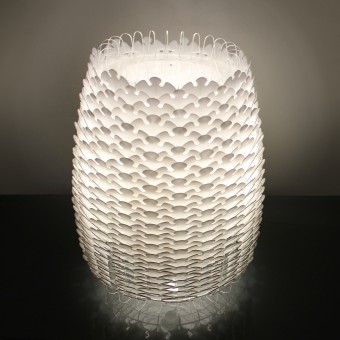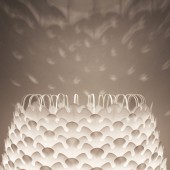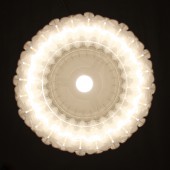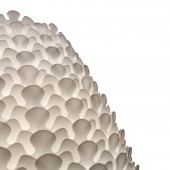Mi-480 Table Lamp by Raza Zahid |
Home > Winners > #60747 |
 |
|
||||
| DESIGN DETAILS | |||||
| DESIGN NAME: Mi-480 PRIMARY FUNCTION: Table Lamp INSPIRATION: The source of inspiration for the lamp stems from the generative systems found in nature and is an attempt to discover the underlying rules and principals of natural systems, which produce structural and material orders of high complexity, efficiency and beauty. In addition to this, the idea was to transform 2D planar geometry into 3-dimensional space/ enclosures that would imply an organic growth and would merge the distinction between silhouette and body. UNIQUE PROPERTIES / PROJECT DESCRIPTION: Designed as a decorative light, the Mi-480 deals with the idea of a scale like skin, creating layers of transparent, translucent and opaque patterns. The gradients of light and shade that result, give the outer skin a sense of visual depth which changes depending upon the viewing angle. A single light source, located in the center, further emphasizes the varied intensities of layering of the skin yet allowing tiny rays of light to escape through the gaps, giving the lamp a visual warmth. OPERATION / FLOW / INTERACTION: The lamp has a visual duality which is dependent on its use. When lit, the light emitting through the layered skin gives it a sense of warmth, fragility and depth. When switched off, the lamp appears more dense, reflective and sculptural. The shifting angles of the scales also control the amount of visual porosity, which can make the lamp appear light or heavy, depending on the viewing angle. The circular profile also allows the lamp to be viewed from all sides. PROJECT DURATION AND LOCATION: The lamp has been designed and produced in Lahore, Pakistan. The design phase was in August 2016 and the prototype was developed in September 2016. The lamp was exhibited at the Koel Gallery, Karachi in March 2017,as part of an exhibition titled 'Product'. FITS BEST INTO CATEGORY: Lighting Products and Fixtures Design |
PRODUCTION / REALIZATION TECHNOLOGY: Owing to the complex geometry that results in the layered skin, the design process relies heavily upon computer modeling, programming and imaging techniques. The grasshopper software is integral to designing the varying scales that make up the skin and to study the amount of layering required. The assembly of the lamp is a labor intensive process, initially requiring the assembly of the structural skeleton, followed by the numerous scales of varying sizes that lock into it. SPECIFICATIONS / TECHNICAL PROPERTIES: 660 mm height X 455 mm diameter at base. The structural frame is made from 5 mm and 3 mm thick clear acrylic and the scales are 2 mm thick translucent acrylic of varying sizes. TAGS: parametric design, Acrylic lamp, decorative lamp, light patterns, raza zahid RESEARCH ABSTRACT: The research started from understanding the rules that govern the formation of patterns in nature and their possible adaption in product design. Along with this, the material research focused on the translation of 2D planar geometry in 3 dimensional forms that would hint at an organic growth. Various prototypes were produced to understand and resolve issues with scale, layering and joinery while maintaining the complexity of the outer skin. CHALLENGE: The main challenge faced was in translating the digital design into a physical product without either compromising on the complexity of the design or making the production process overly complicated. Owing to the limited resources available for product designers in the country, we had to develop a design that would be easy to produce and assemble and ensure structural stability, durability along with the most efficient joinery solutions. ADDED DATE: 2017-09-20 11:45:30 TEAM MEMBERS (1) : IMAGE CREDITS: Image #1: Photographer Raza Zahid, Mi-480(1), 2016 Image #2: Photographer Raza Zahid, Mi-480(2), 2016 Image #3: Photographer Raza Zahid, Mi-480(3), 2016 Image #4: Photographer Raza Zahid, Mi-480(4), 2016 Image #5: Photographer Raza Zahid, Mi-480(5), 2016 |
||||
| Visit the following page to learn more: https://www.facebook.com/razazahidatelie |
|||||
| AWARD DETAILS | |
 |
Mi-480 Table Lamp by Raza Zahid is Winner in Lighting Products and Fixtures Design Category, 2017 - 2018.· Read the interview with designer Raza Zahid for design Mi-480 here.· Press Members: Login or Register to request an exclusive interview with Raza Zahid. · Click here to register inorder to view the profile and other works by Raza Zahid. |
| SOCIAL |
| + Add to Likes / Favorites | Send to My Email | Comment | Testimonials | View Press-Release | Press Kit |
Did you like Raza Zahid's Lighting Design?
You will most likely enjoy other award winning lighting design as well.
Click here to view more Award Winning Lighting Design.








